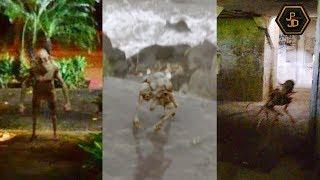10 Most Mysterious Sea Creatures Caught On Camera
Description
10 Most Mysterious Sea Creatures Caught On Camera
If you're new, Subscribe! → http://goo.gl/djmfuX
Facebook: https://www.facebook.com/Top5BestShow
Top 5 Best is the #1 place for all your heart warming stories about amazing people that will inspire you everyday. Make sure to subscribe and never miss a single video!
Leave a like for more shark tank, pawn stars, dr. phil, and other tv show business content. On Top 5 Best, we like to help you in mindset productivity, whether it's how to make more money videos, or going over the biggest mansions in the world, we show everything here! Make sure to subscribe for more amazing videos everyday!
family friendly pg clean
#viralstory #amazingpeople #top5best
Sometimes we get so caught up in the world around us that we forget about all the stunning creatures that live in parts of the world that are uninhabitable by humans. Today we are looking at 10 mysterious deep sea creatures caught on camera.
10. Harp Sponge
https://youtu.be/VC3tAtXdaik?t=14
Typically if we think of a sea sponge, it isn’t a tremendously thrilling species. They generally aren’t much to look at and they typically eat by straining microorganisms out of the surrounding water, consuming the microorganisms in it. But the Harp Sponge isn’t your typical sponge! It was first discovered in 2012 off the coast of California, at a depth of nearly 12,000 feet. The largest one found to date was almost 60 centimeters in length. As for its name, the Harp sponge is named that because of its resemblance to a Lyre - and ancient Greek string instrument, similar to a modern Harp. But perhaps the most shocking thing about the sponge is how it feeds - this particularly carnivorous sponge works alot like leafy land carnivores. Instead of filtering microorganisms the Harp Sponge uses sticky hooks to ensnare prey like copepods and other crustaceans. Once the prey is captured, the harp sponge releases a digestive membrane that surrounds the organism and begins breaking it down, once it’s finished, the sponge is free to absorb the nutrients through a series of specialized pores.
9. Goblin Shark
https://www.youtube.com/watch?v=fYpn2u2Wag4
This incredible deep-sea shark is sometimes called a living fossil due to its astonishing 125 million-year-old lineage. This ancient ancestry may be part of the reason why it looks like nothing else on earth - the aptly named goblin shark has pink skin and a very distinctive profile with an elongated snout that looks as if it’s been flattened. This one of a kind creature can grow to be between10 and 20 feet in length, but while humans and most other animals benefit from 5 different senses like sight, hearing, tasting, smelling and feeling, but the Goblin Shark has something a little extra, its long nose is specially equipped to detect weak electric fields, this ability allows the Goblin Shark to sense prey in the dark depths of the sea. While the Goblin Shark typically prefers to live its days in the depths it has no qualms about coming up to hunt, in fact, a large percentage of this shark’s diet is made up of midwater species such as squid and seed shrimp. Despite its specializations for hunting, the Goblin shark is a surprisingly slow swimmer and relies largely on the element of surprise to capture prey, this is where they benefit from sensing electrical fields then attacking in the right direction.
8. Angler Fish
https://www.youtube.com/watch?v=VqPMP9X-89o
Our next entry looks purely terrifying, and the more you learn about them the more frightening it becomes. Angler fish can live upwards of 3000 feet below the surface, that’s around 914 meters! At that depth, life can be pretty hard and angler fish have a number of bizarre adaptations to survive. Anglerfish live in environments where there are very few living things, this means that finding prey is a bit of a challenge because they don’t eat very much they are experts at energy conservation, in one study 52% of the specimens examined had completely empty stomachs, this means that when an angler fish does try to capture prey they must use as little energy as possible, this means that chasing or battling prey isn’t an option. To get around this, the anglerfish actually fishes, apart from its ghoulish face, one of the first things you will likely notice about it is that it has a rather odd filament protruding from its head, this filament serves a very specific purpose. The angler fish actually uses this filament as a lure to captivate prey which include crustaceans, teleost, and primarily pandalid shrimp, these shrimp are the angler fish’s favorite meal. When they aren’t fishing with their filament, anglerfish are largely scavengers. So we know how they lure prey but the angler fish has yet another bizarre adaptation that is worth talking about.
10 Most Mysterious Sea Creatures Caught On Camera





















Comments